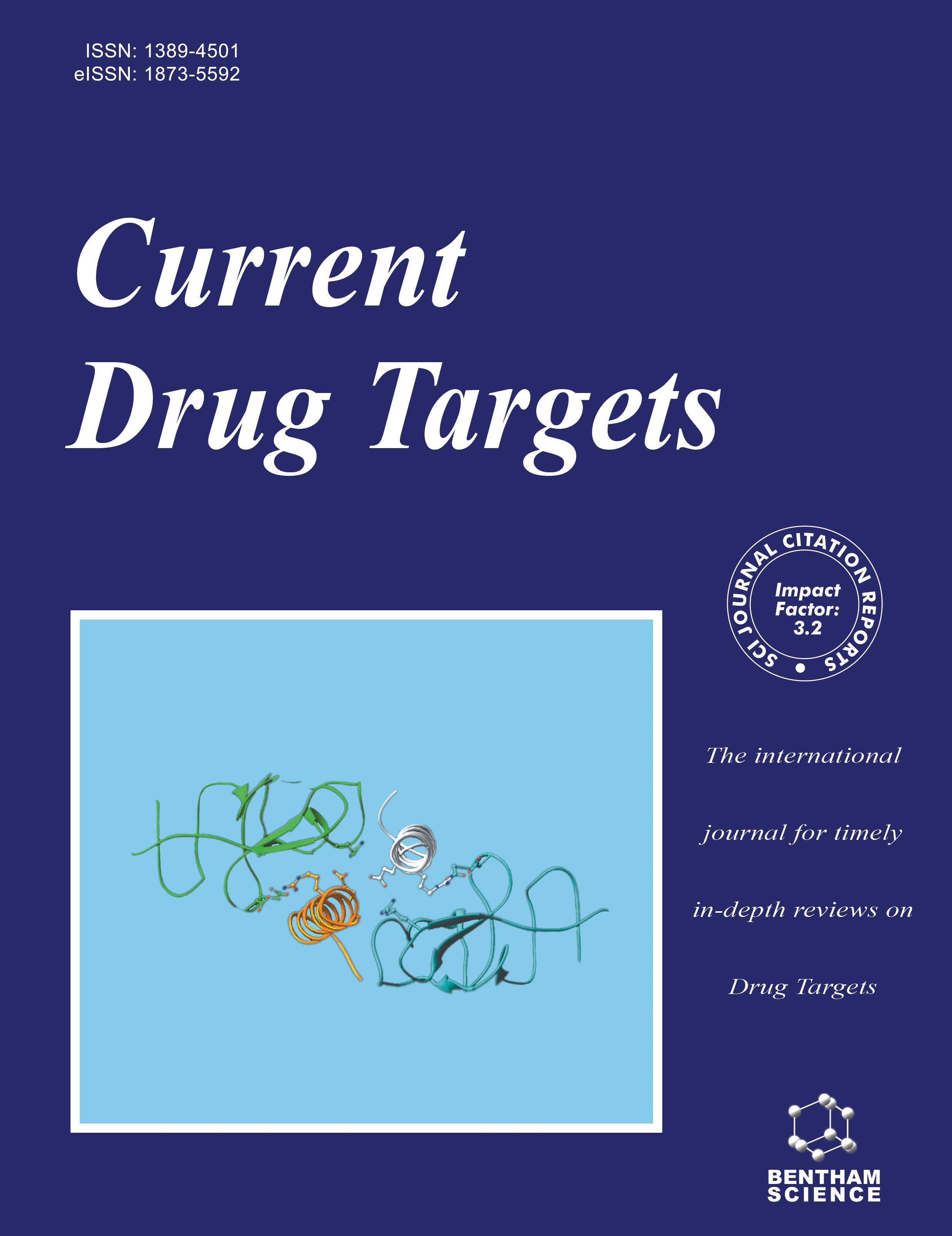- Home
- A-Z Publications
- Current Drug Targets
- Previous Issues
- Volume 24, Issue 2, 2023
Current Drug Targets - Volume 24, Issue 2, 2023
Volume 24, Issue 2, 2023
-
-
The Mechanistic Role of Different Mediators in the Pathophysiology of Nephropathy: A Review
More LessAuthors: Jaspreet Singh, Akash Jain, Rashmi Bhamra, Vaibhav Rathi and Ashwani K. DhingraNephropathy has become the most common reason for end-stage renal disease worldwide. The progression of end-stage renal disease occurs caused by decreased glomerular filtration rate, damage to capillaries in renal glomeruli or a higher risk of cardiovascular morbidity and mortality in diabetic patients. The involvement of mechanism in the development of nephropathy via generation of AGEs, the elevation of growth fa Read More
-
-
-
Bidirectional Relations Between Anxiety, Depression, and Cancer: A Review
More LessEpidemiological evidence continues to accumulate on the effect of stress and depression on cancer initiation and progression. Depression has been introduced as an independent predictor of increased cancer mortality. At the same time, early intervention for depression increases the survival rate. Even some evidence has given prognostic value for depression to predict cancer recurrence and mortality. This article presents cu Read More
-
-
-
Study on Multi-Target Synergistic Treatment of Alzheimer’s Disease Based on Metal Chelators
More LessAuthors: Aihong Yang, Jianhua Wu, Yuhong Chen, Rui Shen and Xiaodi KouAlzheimer's disease (AD) has become the fourth leading cause of death in the world. Due to its complex pathogenesis, there is still a lack of effective drug treatments. Studies have found that the metal dyshomeostasis is closely related to other pathogeneses of AD such as oxidative stress, β-amyloid protein deposits, etc. Therefore, it becomes an important target to find the appropriate metal chelating agents to regu Read More
-
-
-
Melanocortin Receptors: Emerging Targets for the Treatment of Pigmentation, Inflammation, Stress, Weight Disorders and Sexual Dysfunction
More LessAuthors: Miteshkumar R. Maurya, Renuka Munshi and Sachin ZambareMelanocortins are tiny protein molecules formed by the post-translational cleavage of proopiomelanocortin. These are bioactive peptides that are responsible for human and lower animal pigmentation patterns, energy homeostasis, and sexual function modulation. These peptides regulate numerous physiological functions by being generated in the central nervous system and peripheral tissues. Melanocortins elicit their vari Read More
-
-
-
A Comprehensive Insight on Pharmaceutical Co-crystals for Improvement of Aqueous Solubility
More LessAuthors: Jyoti Malik, Anurag Khatkar and Arun NandaVarious drugs are not able to reach the market due to their poor bioavailability and poor solubility in aqueous media. Hence, several approaches are used to enhance the solubility of poorly water-soluble drugs. Co-crystallization is one of the approaches used to enhance the solubility of poorly water-soluble drugs. Co-crystals are solid crystalline substances consisting of two or more ingredients in a stoichiometric ratio in which o Read More
-
-
-
Nascent Nanoformulations as an Insight into the Limitations of the Conventional Systemic Antifungal Therapies
More LessAuthors: Manjot Kaur, Riya Shivgotra, Nitish Bhardwaj, Shagun Saini, Shubham Thakur and Subheet K. JainMore than 150 million people have significant fungal diseases that greatly impact health care and economic expenditures. The expansion of systemic fungal infections and invasive mycoses is being driven by an increase in the number of immunocompromised patients and the recent COVID-19 patients, especially severely ill. There have been numerous cases of fungal infections linked to COVID-19, with pulmonary asp Read More
-
-
-
Digoxin and Outcomes in Patients with Heart Failure and Preserved Ejection Fraction (HFpEF) Patients: A Systematic Review and Meta- Analysis
More LessBackground: One of the major indications for digoxin use is the treatment of heart failure (HF). Although the clinical application of digoxin in long-term outcomes in patients with HF and reduced ejection fraction (HFrEF) patients is well explained, the association between digoxin therapy and outcomes in patients with HF and preserved ejection fraction (HFpEF) is not very clear. Objectives: The aim of this study was to show the Read More
-
-
-
Superoxide Dismutase Inhibitors against Malaria, Leishmaniasis, and Chagas Disease: Systematic Review
More LessIntroduction: Diseases caused by protozoa are one of the leading causes of death worldwide, especially in tropical regions such as Brazil. Chagas disease, leishmaniasis, and malaria are responsible for around 234 million cases and more than 400,000 deaths worldwide. Despite this scenario, drugs for these diseases have several limitations, which justifies the search for new treatments. Iron superoxide dismutase is a promisin Read More
-
Volumes & issues
-
Volume 26 (2025)
-
Volume 25 (2024)
-
Volume 24 (2023)
-
Volume 23 (2022)
-
Volume 22 (2021)
-
Volume 21 (2020)
-
Volume 20 (2019)
-
Volume 19 (2018)
-
Volume 18 (2017)
-
Volume 17 (2016)
-
Volume 16 (2015)
-
Volume 15 (2014)
-
Volume 14 (2013)
-
Volume 13 (2012)
-
Volume 12 (2011)
-
Volume 11 (2010)
-
Volume 10 (2009)
-
Volume 9 (2008)
-
Volume 8 (2007)
-
Volume 7 (2006)
-
Volume 6 (2005)
-
Volume 5 (2004)
-
Volume 4 (2003)
-
Volume 3 (2002)
-
Volume 2 (2001)
-
Volume 1 (2000)
Most Read This Month
Article
content/journals/cdt
Journal
10
5
false
en


